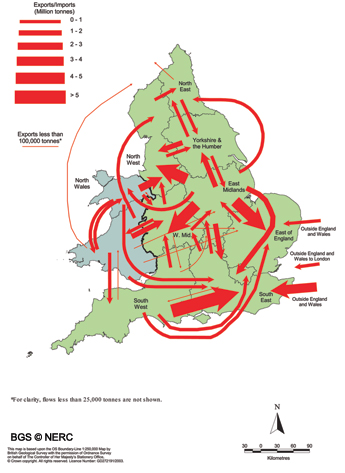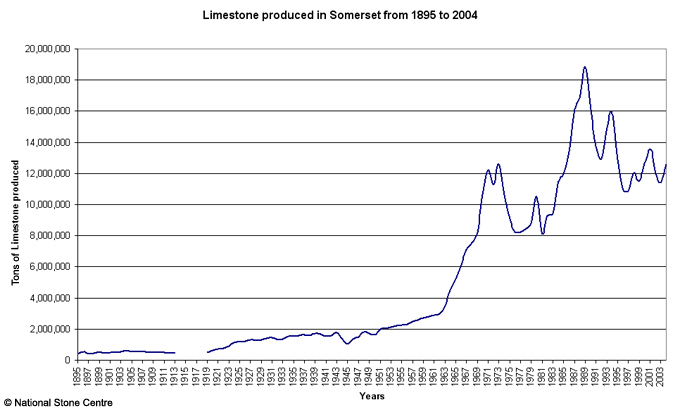
Quarrying
Stone as a resource
Uses of stone | Aggregate resources | Stone production
Stone production
Somerset rock production has been officially recorded since 1895 (with the exception of the World War 1 years and without government publication at county level for much of the 1950s and 60s).
Limestone has been the main rock produced in Somerset and increasingly large proportions of this have been won from Mendip.
Output until 1919 was below 0.5 million tons in most years. By 1931, output had nearly tripled with the build up of road construction and maintenance in the interwar period, but then fluctuated considerably over the next twenty years. In the period 1951 to 62 output rose from 2.0 million tons to 3.0 million tons with post-war reconstruction, continuing to rise rapidly to a new peak in 1973 of 12.6 million tons, largely on the basis of 'exports' to south-east England and the growing use of rail transport. Increased demand led to a new peak of 18.8 million tons in 1990 at a time when national construction output was especially high. Since then, with falling demand, production has fallen back to a level generally between 11.0 and 14.0 million tons per annum. Output of igneous rocks (mostly the Silurian andesite) is currently understood to be about 0.5 million tons per annum.
Almost all the stone quarried is used as aggregates, mainly for making roads (with andesite for the surface and limestone for the lower road courses) and for concrete. Smaller amounts of limestone are used for lime (used mainly in steel making), for soil conditioning on farms and as a building stone. Somerset ranks third after Derbyshire and Leicestershire in terms of aggregates output. Since 1974, Somerset production of crushed rock has averaged about 10% of the national output.
In recent years, all crushed rock aggregate production in Somerset (typically about 11.5 million tons per annum) has been won from Mendip. County output in recent years has equated to about half the rock production for the whole of the South West region (22–23 million tons). Over the last 20 years, 62–70% of rock produced in the south-west has been used within the region. Between a third and a quarter (and generally falling), and mostly from Somerset, has been destined for the south-east of England.
In annual tonnage terms, south-east deliveries rose to over 11 million tons in the late 1980s, fell to just over 5 million tons in the 1990s, moving back to over 7 million tons in 2001.
Total permitted reserves of rock in Somerset quarries (2003) were 671 million tons, equivalent to 54 years of production, almost exactly half of the regional total. As well as active quarries, the Somerset figure included reserves at about a dozen (mostly small) inactive sites.
- Home
- Overview maps
- Locality
areas
- Cheddar Gorge
- Charterhouse
- Blackdown
- Burrington Combe
- Shipham & Rowberrow
- Crook Peak & Axbridge
- Banwell to Churchill
- Priddy
- Harptree & Smitham Hill
- Draycott & Westbury-sub-Mendip
- Wookey Hole & Ebbor Gorge
- Wells
- Great Elm & Vallis Vale
- Mells & the Wadbury Valley
- The Vobster area
- The Whatley area
- Torr Works & Asham Wood
- Beacon Hill
- Stoke St Michael & Oakhill
- Holwell & Nunney
- Shepton Mallet & Maesbury
- Gurney Slade & Emborough
- The Nettlebridge valley
- Geology
- Minerals and mines
- Quarrying
- Caves and karst
- Biodiversity
- Detailed site information
- Acknowledgements
- External links
- Search
- Site map

